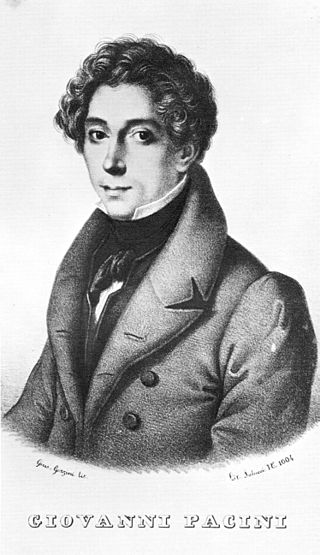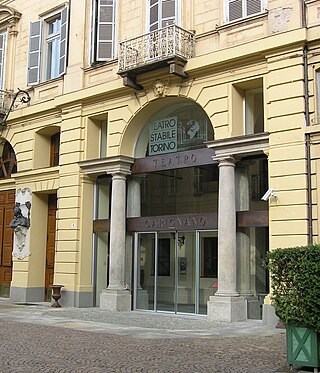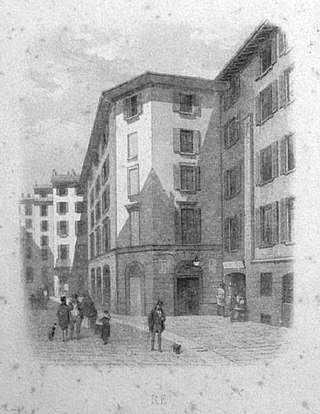
Giovanni Pacini was an Italian composer, best known for his operas. Pacini was born in Catania, Sicily, the son of the buffo Luigi Pacini, who was to appear in the premieres of many of Giovanni's operas. The family was of Tuscan origin, living in Catania when the composer was born.

L'italiana in Algeri is an operatic dramma giocoso in two acts by Gioachino Rossini to an Italian libretto by Angelo Anelli, based on his earlier text set by Luigi Mosca. It premiered at the Teatro San Benedetto in Venice on 22 May 1813. The music is characteristic of Rossini's style, remarkable for its fusion of sustained, manic energy with elegant, pristine melodies.

Giuseppe Felice Romani was an Italian poet and scholar of literature and mythology who wrote many librettos for the opera composers Donizetti and Bellini. Romani was considered the finest Italian librettist between Metastasio and Boito.

Il falegname di Livonia, o Pietro il grande, czar delle Russie is an 1819 opera buffa in two acts with music by Gaetano Donizetti set to a libretto by Gherardo Bevilacqua-Aldobrandini. The libretto was based in part on Felice Romani's libretto for Giovanni Pacini's opera Il falegname di Livonia, which had just been presented at La Scala in Milan on 12 April 1819. Another source was Alexandre Duval's comedy Le menuisier de Livonie, ou Les illustres voyageurs (1805).

Filippo Galli was an Italian opera singer who began his career as a tenor in 1801 but went on to become one of the most acclaimed basses of the bel canto era, with a voice known for its wide range, extreme agility, and expressivity, and a remarkable gift for acting.

Adina is an operatic farsa in one act by Gioachino Rossini with a libretto by Marchese Gherardo Bevilacqua-Aldobrandini. The opera develops the popular theme of the "abduction from the seraglio". The première took place on 22 June 1826 at the Teatro Nacional de São Carlos, Lisbon.

Eugenia Tadolini was an Italian operatic soprano. Admired for the beauty of her voice and stage presence, she was one of Donizetti's favourite singers. During her career she created over 20 leading roles, including the title roles in Donizetti's Linda di Chamounix and Maria di Rohan and Verdi's Alzira. She was born in Forlì and studied music there and in Bologna before making her debut in Florence in 1828. She sang in all of Italy's leading opera houses, as well as in Paris, Vienna, and London before retiring from the stage in 1852. She spent her remaining years first in Naples, where she had been the Teatro San Carlo's reigning prima donna for many years, and then in Paris, where she died of typhoid fever at the age of 63. From 1827 to 1834, she was married to the Italian composer and singing teacher, Giovanni Tadolini.
Giuseppe Fioravanti was an Italian opera singer active during the first half of the 19th century. Although one of the most important and popular basso buffos of his generation, there is only a relatively small amount of information available about his life. He had a highly fruitful partnership with the Teatro Nuovo in Naples and is best known today for creating roles in the world premieres of numerous operas by Gaetano Donizetti.
Domenico Gilardoni (1798–1831) was an Italian opera librettist, most well known for his collaborations with the composers Vincenzo Bellini and Gaetano Donizetti.

The Teatro Carignano is a theatre in Turin and one of the oldest and most important theatres in Italy. Designed by Benedetto Alfieri, it is located opposite the Palazzo Carignano. Building commenced in 1752 and the theatre was inaugurated the following year with a performance of Baldassare Galuppi's opera, Calamità de' cuori. Much of the theatre was destroyed in a fire in 1786, but it was rebuilt in a few months using Alfieri's original plans. Since then it has undergone several renovations. Although today it is primarily used for performances of plays, in the past it was an important opera house. The theatre is owned by the City of Turin but administered by the theatre company, Teatro Stabile di Torino, and is one of the company's principal performing venues.

Maria Caterina Rosalbina Caradori-Allan was a French operatic soprano.

L'ultimo giorno di Pompei is an opera in two acts composed by Giovanni Pacini to an Italian libretto by Andrea Leone Tottola. It premiered to great success at the Teatro San Carlo in Naples on 19 November 1825 followed by productions in the major opera houses of Italy, Austria, France, and Portugal. When Pacini's popularity declined in the mid-19th century, the opera was all but forgotten until 1996 when it received its first performance in modern times at the Festival della Valle d'Itria in Martina Franca. L'ultimo giorno di Pompei influenced either directly or indirectly several other 19th-century works, most notably Karl Bryullov's 1833 painting, The Last Day of Pompeii.

Giuseppe de Begnis was an Italian operatic bass singer. Born in Lugo di Romagna, he started his musical education when he was 7 years old, under Padre Bongiovanni, and sang soprano in the church. At age 15 he had serious problems with his voice and began studying acting under Mandini, a famous actor of the time. His father did not want Giuseppe to become a comedian and in due course the young man became a pupil of the composer Giovanni Morandi, the husband of the singer Rosa Morandi.

La Dori, overo Lo schiavo reggio is a tragi-comic opera in a prologue and three acts composed by Antonio Cesti to a libretto by Giovanni Filippo Apolloni. It was first performed in the court theatre at Innsbruck in 1657. The story is set in Babylon on the shores of the Euphrates and is a convoluted tale of mistaken identities—a female protagonist who disguised as a man eventually regains her lost lover, and a man disguised as a woman who causes another man to fall in love with him. In several respects it resembles the plot of Cesti and Apolloni's earlier opera L'Argia and foreshadows Apostolo Zeno's libretto for Gli inganni felici (1695) and Metastasio's libretto for L'Olimpiade (1733). The first Italian staging of La Dori was in Florence in 1661 for the wedding of Cosimo III de' Medici, Grand Duke of Tuscany. It subsequently became one of the most popular operas in 17th-century Italy. The opera was revived three times in the 20th century, beginning in 1983.
Ermanno Picchi was an Italian composer, pedagogue and music critic who played an active role in the musical life of Florence from 1836 until his early death in 1856.

Carolina Bassi was an Italian contralto who knew Rossini, Meyerbeer, Donizetti and Bellini.

The Teatro Re was a theatre in Milan, located near the Piazza del Duomo and named for its proprietor, Carlo Re. It functioned as both a prose theatre and an opera house and saw the world premieres of numerous operas, including four by Giovanni Pacini. Designed by Luigi Canonica, the theatre was inaugurated in 1813, closed in 1872, and demolished in 1879.
Pio Botticelli was an Italian bass-baritone active in the opera houses of Italy from 1810 until the mid-1840s. Amongst the numerous roles he created in world premieres were Pietro il Grande in Donizetti's Il falegname di Livonia and The Caliph in Pacini's La schiava in Bagdad. He also sang the role of Leucippo in the Austrian premiere of Rossini's Zelmira.
Savino Monelli was an Italian tenor prominent in the opera houses of Italy from 1806 until 1830. Amongst the numerous roles he created in world premieres were Giannetto in Rossini's La gazza ladra, Enrico in Donizetti's L'ajo nell'imbarazzo and Nadir in Pacini's La schiava in Bagdad. He was born in Fermo where he initially studied music. After leaving the stage, he retired to Fermo and died there five years later at the age of 52.

Luigi Pacini was an Italian opera singer who appeared on the principal stages of his native country as well as in Spain and Austria in a career that spanned over 30 years. He began his career as a tenor but in 1805 started singing bass roles and rose to prominence in that repertoire. Amongst the numerous roles he created in world premieres were Geronio in Rossini's Il turco in Italia and Parmenione in his L'occasione fa il ladro. Pacini was born in the Province of Pistoia and died in Viareggio where in his later years he taught singing at the conservatory founded by his son, Giovanni Pacini.














